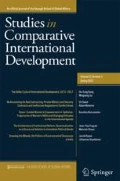Abstract
During the past decade Cuba has become a haven for international sex tourists. How do we explain this phenomenon? This article contends that the Cuban experience must be understood as part of a set of larger global processes. It utilizes a commodity chains framework in order to uncover the links between the local sex tourism industry and these larger international processes. The framework highlights aspects of production and consumption of an illicit blobal commodity and shows how tourism aimed at consuming sexual services has become a truly global industry in recent years. It also, however, seeks to avoid global determinism by showing how particular aspects of the Cuban political economy and policymaking have shaped the local development and organization of the Cuban link in the chain.
Similar content being viewed by others
References
Acosta, Dalia. 1997. “Culture Tourism: Cuba Brushes up its Tourist Image.”Interpress Service, September 19.
Adams. David. 1995. “In Cuba Sex for Sale.”St. Petersburg Times, September 18.
Appadurai, Arjun. 1996.Modernity at Large: Cultural Dimensions of Globalization. Minneapolis: University of Minnesota Press.
Appelbaum, Richard P. and Gary Gereffi. 1994. “Power and Profits in the Apparel Commodity Chain.” Pp. 42–62 inGlobal Production: The Apparel Industry in the Pacific Rim, eds. E. Bonacich, L. Cheng, N. Chinchilla, N. Hamilton, and P. Ong. Philadelphia: Temple University Press.
Beck, Ulrich. 2000.What is Globalization? Cambridge: Polity Press.
Bishop, Ryan and Lillian S. Robinson. 1998.Night Market: Sexual Cultures and the Thai Economic Miracle. New York: Routledge.
Castells, Manuel. 1996.Rise of the Network Society. Cambridge: Blackwell.
Clancy, Michael. 1998. “Commodity Chains, Services and Development: Theory and Preliminary Evidence from the Tourism Industry.”Review of International Political Economy 5, 1: 122–48.
Cohen, Erik. 1982. “Thai Prostitutes and Farang Men: The Edge of Ambiguity.”Annals of Tourism Research 9: 403–28.
Cox, Kevin R. 1997. “Globalization and the Politics of Distribution: A Critical Assessment.” Pp. 115–136 inSpaces of Globalization: Reasserting the Local, ed. K. Cox. New York: The Guilford Press.
Danaher, Kevin, ed. 1996.Corporations Are Gonna Get Your Mama: Globalization and the Downsizing of the American Dream. Monroe, ME: Common Courage Press.The Economist. 1998.
The Economist. 1998. “The Sex Industry: Giving the Customer What he Wants,” 346(8055), Feb. 14–20, p. 21.
Enloe, Cynthia. 1989.Bananas, Beaches and Bases: Making Feminist Sense of International Relations. Berkeley: University of California Press.
Espino, Maria Dolores. 1994. “Tourism in Cuba: A Development Strategy for the 1990s?” Pp. 100–110 inCuba at the Crossroads: Politics and Economics After the Fourth Party Congress, ed. Jorge F. Pérez-López. Gainsville: University of Florida Press.
Fernandez, Nadine. 1999. “Back to the Future? Women, Race, and Tourism in Cuba.” Pp. 81–89 inSun, Sex and Gold: Tourism and Sex Work in the Caribbean, ed. K. Kempadoo. Oxford: Rowman and Littlefield.
Freed, Kenneth. 1994. “Castro Plays a Capitalist Card, Seeking More Tourist Dollars.”Los Angeles Times, January 3: 1.
Fusco, Coco. 1996. “Hustling for Dollars.” Pp. 151–166 inGlobal Sex Workers: Rights, Resistance and Redefinition, eds. K. Kempadoo and J. Doezema. London: Routledge.
Gereffi, Gary. 1994a. “The Organization of Buyer-Driven Commodity Chains: How U.S. Retailers Shape Overseas Production Networks.” Pp. 95–122 inCommodity Chains and Global Capitalism, eds. G. Gereffi and M. Korzeniewicz. Westport, CT: Greenwood Press.
Gereffi, Gary. 1994b. “Contending Perspectives on Regional Integration: Development Strategies and Commodity Chains in Latin America and East Asia.” Paper presented at the XVIII International Congress of the Latin American Studies Association, Atlanta.
Gereffi, Gary, Miguel Korzeniewicz, and Roberto P. Korzeniewicz. 1994. “Introduction: Global Commodity Chains.” Pp. 1–14 inCommodity Chains and Global Capitalism, eds. G. Gereffi and M. Korzeniewicz. Westport, CT: Greenwood Press.
Gertler, Meric S. 1997. “Between the Global and the Local The Spatial Limits to Productive Capital.” Pp. 45–63 inSpaces of Globalization: Reasserting the Local, ed. Kevin R. Cox. New York: The Guilford Press.
Geske, Mary and Michael Clancy. 2000.Sexploitation? Sex Tourism in Cuba. Pew Case Study 236. Washington, DC: Institute for the Study of Diplomacy, Georgetown University.
Giddens, Anthony. 2000.Runaway World: How Globalization is Shaping Our Lives. New York: Routledge.
Hall, C. Michael. 1992. “Sex Tourism in South-East Asia.” Pp. 64–74 inTourism and the Less Developed Countries, ed. David Harrison. London: Belhaven.
Hall, Derek. 1992. “Tourism Development in Cuba.” Pp. 102–120 inTourism and the Less Developed Countries, ed. D. Harrison. London: Belhaven.
Hirst, Paul and Grahame Thompson. 1996.Globalization in Question. Cambridge: Polity Press.
Hopkins, Terrence K. and Immanuel Wallerstein. 1986. “Commodity Chains in the World Economy Prior to 1800.”Review 10, 1: 157–70.
Kaban, Elif. 1998. “UN Labor Body Urges World to Recognize Sex as Legal Business.”Reuters, August 19.
Kempadoo, Kamala. 1998. “Introduction: Globalizing Sex Workers' Rights.” Pp. 1–28 inGlobal Sex Workers: Rights, Resistance, and Redefinition, eds. K. Kempadoo and J. Doezema. New York: Routledge.
Knight Ridder Newspapers. 1998. “Cuban Hookers Rounded up at Infamous Resort,” June 7.
Korzeniewicz, Miguel. 1994. “Commodity Chains and Marketing Strategies: Nike and the Global Footwear Industry.” Pp. 247–265 inCommodity Chains and Global Capitalism, eds. G. Gereffi and M. Korzeniewicz. Westport, CT: Greenwood Press.
Krugman, Paul. 1996. “The Localization of the World Economy.” InPop Internationalism, ed. P. Krugman. Cambridge: MIT Press.
Lee, Naeyoung and Jeffrey Cason. 1994. “Automobile Commodity Chains in the NICs: A Comparison of South Korea, Mexico and Brazil.” Pp. 223–243 inCommodity Chains and Global Capitalism, eds. G. Gereffi and M. Korzeniewicz. Westport, CT: Greenwood Press.
Lee, Wendy. 1991. “Prostitution and Tourism in South-East Asia.” Pp. 79–103 inWorking Women: International Perspectives on Labour and Gender Ideology, eds. N. Redclift and M. Sinclair. London: Routledge.
Leheny, David. 1995. “A Political Economy of Asian Sex Tourism.”Annals of Tourism Research 22, 2: 367–84.
Maybarduk, Gary H. 1999. “The State of the Cuban Economy, 1998–99.” Pp. 1–11 inCuba in Transition, Proceedings of the Association for the Study of the Cuban Economy, Vol. 9.
McCannell, Dean. 1989.The Tourist: A New Theory of the Leisure Class, 2nd edition. New York: Schocken.
Mesa-Lago, Carmelo. 1998. “The Cuban Economy in 1997–98: Performance and Policies.” Pp. 1–8 inCuba in Transition, Proceedings of the Association for the Study of the Cuban Economy, Vol. 8.
Moon, Kathleen H.S. 1997.Sex Among Allies. New York: Columbia University Press.
Mullings, Beverly. 1999. “Globalization, Tourism, and the International Sex Trade.” Pp. 55–80 inSun, Sex and Gold: Tourism and Sex Work in the Caribbean ed. K. Kempadoo. Oxford: Rowman and Littlefield.
Navarro, Mireya. 1999. “As it Opens to Outsiders, Cuba is Infected by Crime.”New York Times, April 4.
Notimex. 1999. “High Ranking tourism Officials Charged with Corruption, Fired.” Reproduced by the BBC Summary of World Broadcasts, June 12.
O'Connell Davidson, Julia. 1996. “Sex Tourism in Cuba.”Race and Class 38:1.
—. 1998.Prostitution, Power and Freedom. Ann Arbor: University of Michigan.
Ohmae, Kenichi. 1995. “Putting Global Logic First.” Pp. 129–137 inThe Evolving Global Economy, ed. K. Ohmae. Cambridge: Harvard.
Patullo, Polly. 1996.Last Resorts: The Cost of Tourism in the Caribbean. London: Cassell.
Poon, Auliana. 1990. “Flexible Specialization and Small Size: The Case of Caribbean Tourism.”World Development 18, 1: 109–119.
Pope, Cynthia. 1999. “Gendered Prevention: Women and HIV Risk and Prevention in Havana, Cuba.” Paper Presented at the Association of American Geographers meetings, Honolulu (March).
Rabach, Eileen and Eun Mee Kim. 1994. “Where is the Chain in Commodity Chains? The Service Sector Nexus.” Pp. 123–41 inCommodity Chains and Global Capitalism, eds. G. Gereffi and M. Korzeniewicz. Westport, CT: Greenwood Press.
Reich, Robert. 1991.The Work of Nations: Preparing Ourselves for the 21 st Century Capitalism. New York: Knopf.
Rice, John. 1999. “Suddenly ‘psst’ is Passe.”Associated Press, January 22.
Rodrik, Dani. 1997.Has Globalization Gone Too Far? Washington, DC: Institute for International Economics.
Schwartz, Rosalie. 1997.Pleasure Island: Tourism and Temptation in Cuba. Lincoln: University of Nebraska Press.
Smith, Lois and Alfred Padula. 1996.Sex and Revolution: Women in Socialist Cuba. New York: Oxford University Press.
Storper, Michael. 1997. “Territories, Flows, and Hierarchies in the Global Economy.” Pp. 19–44 inSpaces of Globalization: Reasserting the Power of the Local, ed. Kevin R. Cox. New York: The Guilford Press.
Strange, Susan. 1996.The Retreat of the State: The Diffusion of Power in the World Economy. Cambridge: Cambridge University Press.
Suddaby, Charles. 1997. “Cuba's Tourism Industry.” Pp. 123–130 inCuba in Transition, Association for the Study of the Cuban Economy, Vol. 7.
Thomas-Emeagwali, Gloria, ed. 1995.Women Pay the Price: Structural Adjustment in Africa and the Caribbean. Trenton, NJ: Africa World Press.
Tilly, Charles. 1984.Big Structures, Large Processes, Huge Comparisons. New York: Russell Sage Foundation.
Urry, John. 1995.Consuming Places. London: Routledge.
Varadarajan, Tunku. 1996. “Time-Bomb that Flies in From Havana.”The Times, July 10.
Weiss, Linda. 1998.The Myth of the Powerless State. Ithaca, NY: Cornell University Press.
World Tourism Organization (WTO). 2000. “World Tourism Results Revised Upwards.”WTO News.
World Travel and Tourism Council (WTTC). 1999a. “WTTC Key Statistics.” WTTC.
World Travel. 1999b. “Travel and Tourism's Economic Impact.” WTTC.
Wriston, Walter. 1992.The Twilight of Sovereignty. New York: Scribner.
Author information
Authors and Affiliations
Rights and permissions
About this article
Cite this article
Clancy, M. The globalization of sex tourism and Cuba: A commodity chains approach. St Comp Int Dev 36, 63–88 (2002). https://doi.org/10.1007/BF02686333
Issue Date:
DOI: https://doi.org/10.1007/BF02686333




